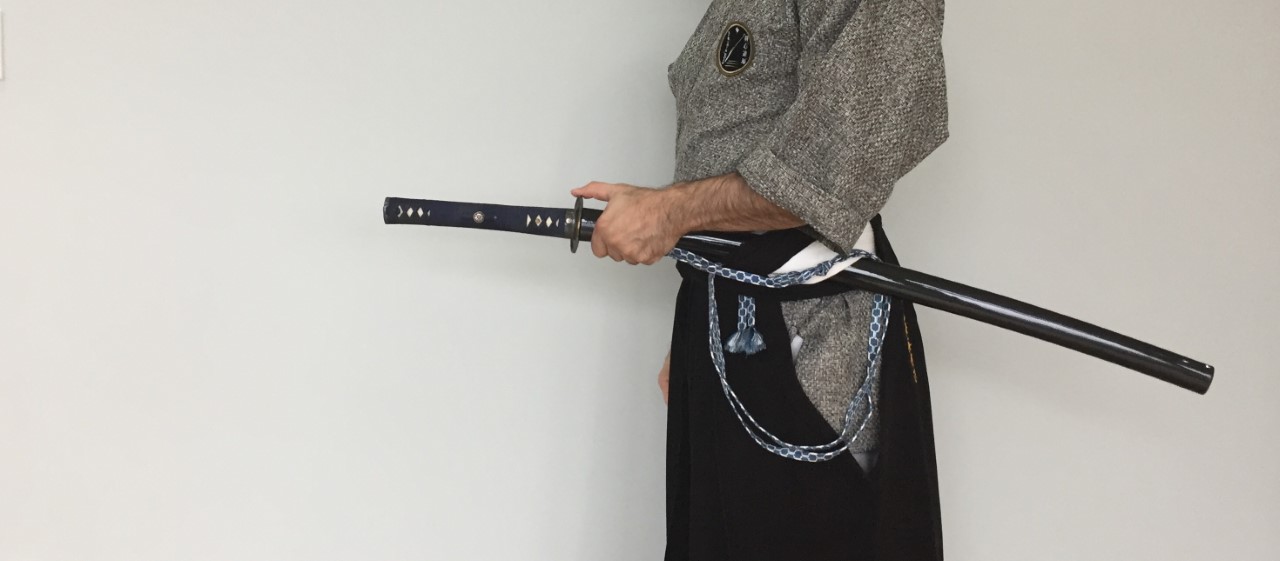Iaido

Ken Shin Dojo is proud to be affiliated with Kokusai Remei (World MJER Iaido Federation).
"I humbly present my thoughts to you on the following matters and pray that you do not think of me as one who would consider himself as wise as you.
Your esteemed servant, Hidetomo Nakadai"
From The Shogun's Scroll, by Stephen F Kaufman
It is my intent to present this information with the same humility as Hidetomo Nakadai and hope that you will gain insight and success in your journey along the way.
Bahman Ebrahimi
No ego, no mind; a calm and gentle spirit
Saya No Uchi No Kachi
The sword in the scabbard, winning without drawing IAIDO ((ee-eye-do) is an authentic sword art of reacting to a surprise attack by counter attacking with a katana (Japanese sword).
Iaido originated in the katana techniques of the samurai of Japan around 1390.
In times of peace, the reasons for studying martial arts changed. Hayashizaki Jinsuke Minamoto Shigenobu (1546-1621) is considered the legendary founder of Iaido for not only classifying a system of batto jutsu (sworddrawing techniques), but also for promoting the idea that practicing sword forms with meditative intent can make one a better person, and in doing so, benefit society as well.
The Tokugawa Shogunate (1603-1867) united the country after a long period of civil discord. Directives soon followed to convert the samurai from warriors to civilians better able to serve in the government. The Meiji government (post-feudal period from 1863-1912) broke up the shogunal class system (feudal class system) and forbid the wearing of daisho (the paired long & short swords) after 1868. While members of the samurai class continued to practice sword techniques, the emphasis changed from fighting to self-discipline and character building.
Following the Tokugawa Shogunate, under the Meiji Restoration (1868-1911), Iaido began to flourish. Traditionally, only samurai men practiced long sword, but nowadays, men and women from all walks of life around the world study Iaido. The standard of training is exactly the same for both men and women.
The intent of Iaido is not to overcome the enemy, but to overcome one’s self. Iaido technique is highly refined; the three key components being simplicity, directness, and determination. Every unnecessary movement has been eliminated. As a result, authentic Iaido does not present well for demonstrations, as it does not contain flashy or showy movements. This graceful and dignified art exemplifies Japanese Budo in strengthening and developing character.
Iaido is a true and an authentic Budo that proved its martial values in a time of constant battle and warfare. Its purpose is to develop awareness, centeredness, sincerity, calmness, and mental and physical harmony through the practice of traditional sword techniques.

Ken Shin Dojo is proud to be affiliated with Kokusai Remei (World MJER Iaido Federation).
"I humbly present my thoughts to you on the following matters and pray that you do not think of me as one who would consider himself as wise as you.
Your esteemed servant, Hidetomo Nakadai"
From The Shogun's Scroll, by Stephen F Kaufman
It is my intent to present this information with the same humility as Hidetomo Nakadai and hope that you will gain insight and success in your journey along the way.
Bahman Ebrahimi
No ego, no mind; a calm and gentle spirit
Saya No Uchi No Kachi
The sword in the scabbard, winning without drawing IAIDO ((ee-eye-do) is an authentic sword art of reacting to a surprise attack by counter attacking with a katana (Japanese sword).
Iaido originated in the katana techniques of the samurai of Japan around 1390.
In times of peace, the reasons for studying martial arts changed. Hayashizaki Jinsuke Minamoto Shigenobu (1546-1621) is considered the legendary founder of Iaido for not only classifying a system of batto jutsu (sworddrawing techniques), but also for promoting the idea that practicing sword forms with meditative intent can make one a better person, and in doing so, benefit society as well.
The Tokugawa Shogunate (1603-1867) united the country after a long period of civil discord. Directives soon followed to convert the samurai from warriors to civilians better able to serve in the government. The Meiji government (post-feudal period from 1863-1912) broke up the shogunal class system (feudal class system) and forbid the wearing of daisho (the paired long & short swords) after 1868. While members of the samurai class continued to practice sword techniques, the emphasis changed from fighting to self-discipline and character building.
Following the Tokugawa Shogunate, under the Meiji Restoration (1868-1911), Iaido began to flourish. Traditionally, only samurai men practiced long sword, but nowadays, men and women from all walks of life around the world study Iaido. The standard of training is exactly the same for both men and women.
The intent of Iaido is not to overcome the enemy, but to overcome one’s self. Iaido technique is highly refined; the three key components being simplicity, directness, and determination. Every unnecessary movement has been eliminated. As a result, authentic Iaido does not present well for demonstrations, as it does not contain flashy or showy movements. This graceful and dignified art exemplifies Japanese Budo in strengthening and developing character.
Iaido is a true and an authentic Budo that proved its martial values in a time of constant battle and warfare. Its purpose is to develop awareness, centeredness, sincerity, calmness, and mental and physical harmony through the practice of traditional sword techniques.
